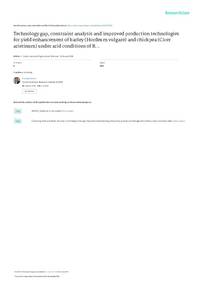Technology gap, constraint analysis and improved production technologies for yield enhancement of barley (Hordeum vulgare) and chickpea (Cicer arietinum) under arid conditions of Rajasthan

Authors:
Agriculture is the mainstay of livelihood in arid region of Rajasthan and improvement in the agricultural productivity is one of the most important strategies to reduce poverty, ensuring food and livelihood security in the region. Moreover, the region is highly prone to recurrent drought owing to its harsh and frequent climatic aberrations. Consequently, limit the scope of sustainable crop production and encourage the degradation of natural resources. Therefore, majority of farming community is engaged in subsistence farming due lack of adequate resources and because of poor and instable crop production, socio-economic status of the farmers is very poor. This has necessitated improvement in agricultural production by imposing improved production technologies. Barley (Hordeum vulgare L.) and chickpea (Cicer arietinum L.) are the most important food grain crops grown during rainy season under conserved moisture or limited irrigation condition of the region, but average productivity of both the crops is very low. In addition to unfavourable climatic conditions, use of traditional practices is also important factor responsible for low yield. The present study was therefore conducted in five villages of three districts of arid region of Rajasthan during 2013-14 and 2014-15 to understand socio-economic profile of the farmers and also to study the effect of improved production technologies on the yield and economics of barley and chickpea. The results revealed that majority of the respondents (37.93%) had middle level of education and 55.17% of total respondents belong to medium farm size category. None of the respondents has used improved production technologies as per the recommendations for the cultivation of barley and chickpea crops, indicating 100% adoption gap. Further, all the respondents (100%) possessed low price of crop produce as major constraint followed by lack of marketing facility (96.55%), non-availability of improved seed (89.65%), high cost of cultivation ( 81.03%) and lack of effective extension agencies (81.03%). The grain yield of barley and chickpea showed remarkable improvement due to adoption of improved production technologies. Increase
in the grain yield of barley and chickpea recorded by 19.37 to 24.83% and 28.63 to 38.07% respectively, over farmer’s practice. Increase in net return was obtained up to 43.78% due to improved production technologies of barley and 50.11% with improved production technologies of chickpea. However, socio-economic status and livelihood of the farmers can be improved due to the adoption of improved production technologies of crops in arid region of Rajasthan.
